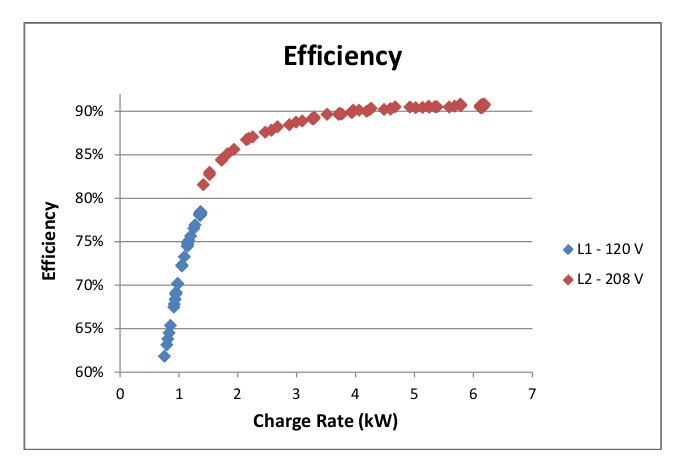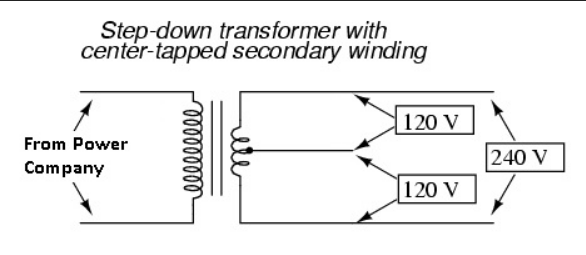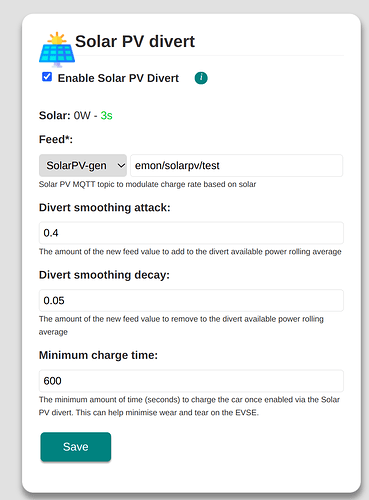i am looking to charge our PHEV with our un-used solar energy(standard 4KW system)- i origonal thought to simple use a solar diverter(iBoost or simular) to a 13 amp socket but i have been informed that the there is a minimum charge level accepted by the car of 6amps or 1440w (6ampx240v) this is too high a starting point and would be useless for early mornings, or winter low generation times. would it be possible to divert the solar PV into a 110v transformer (builders type) and then in to the car, would reducing the voltage to 110 reduces the minimum charge to 660w(6amps x 110v)? and is all this possible?
The OpenEVSE/EmonEVSE both support PV divert and can run off of 110v. However it is more the vehicle that is the thing you need to check can charge off of 110v that is where the actual charger is, the EVSE is basically a switch with some signalling to indicate the available current.
yes the vehicle imput is 110v-240v and 6-32 amp
Then I think it should work. You probably need to setup up the EVSE as you would in the US, so level 1, which will limit the current to a max of 16A but that should be fine for a PHEV, my outlander is a max of 16A anyway.
Just to be 100% clear - DO NOT ATTEMPT TO CHARGE YOUR CAR LIKE THIS!!!
These devices are designed to be be used with resistive heating elements, either by chopping up the AC sine wave to lower the actual power available or by “getting clever” in the case of devices like the Solic.
These “modified” sine waves will damage your cars electronics, as the car will still attempt to pull whatever voltage the EVSE you are using lets it.
As has been mentioned above use OpenEVSE or just a portable EVSE which has a button to set the charge level. In this case the EVSE (charger) tells the car the maximum rate that it can charge at (via a communications pin in the socket), so it charges slower.
Thank you for your comments and warnings, i am happy with the advise that the EVSE will accomadate my plans, But a few qs-
- by setting it up as a level 1 charger, is that setting the output rate at 110V 6a minimum? or will i have to tranformer the input power down to 110v for the EVSE to recognise its has US power imput?
2)Vster- i am not trying to limit the charge to a “maximum” but trying to create a much lower minimum wattage ( i apriciate this will require a longer charge) - Reading the EVSE guide it mentions when set to eco mode charge will begin when genertion reaches 6amps(1440wats) but it will continue to charge if rate drops below this level to save work for the relay, is the made up with grid power to meet the short fall to 6amps or just allowed to flutuate as the solar does?
The EU version of the OpenEVSE only supports 240V, the minimum charge rate is 6A*240V.
The current OpenEVSE firmware will pause the charge when the excess power drops below 6A. You will need an emonPi to monitor your solar PV in order to use OpenEVSE EcoMode
is it possible to get hold of a 110V (US) version? and power it through a 110v transformer?
what happens to charge when the solar flutuates around the1.4kw generation, does the unit click in and out of charge as the solar changes? or is this levellld out with grid power?
You would have to order a US spec one from OpenEVSE in the States: https://store.openevse.com/. Charging at 110V 6A will result in low efficiency, it’s also worth checking that your EV can support 110V, I’m not sure if European spec cars would support this:

There is a smoothing algorithm and minimum charge time to avoid rapid cycling, all options are customisable:
Thanks for the fast responce,
The spec on our car says input of 110v-240v and 6amps-32 amps.
Also
Your graph shows the L1 charger starts charging around 700w(6amps) but finishes around 1400w(13amps) is this the upper limit of its charge as a L1 charger?
I believe 13A is the maximum continuous current for a standard 110V outlet. In the USA they use two phases to provide 220V for higher power charging.
If you’re referring to a “standard” 120 volt outlet as used in the US,
the max current rating is 15 Amps.
We use two legs of a single phase to produce 240 Volts.
One phase split into two legs by using the center-tap of a transformer as the neutral leg.

EVSE’s are rated for the continuous current, the Nissan LEAF EVSE is rated at 12A, the EV could potentially be charging for several days, I imagine the socket would get rather warm if 15A was drawn for 48+hrs! It’s the same in the UK, our sockets are rated at 13A max but EVs charge at 10A max since this is the continuous current rating. Therese’s days most people have hardwired EVSEs on a dedicated circuit which can charge at 32A 7kW continuously or 22kW on three-phase.
Got it, this is what I meant, I just couldn’t remember of the correct nomenclature! Thanks
Which is within the spec for max continuous current from a 15 Amp receptacle on a 15 Amp circuit.
It would indeed.
I’d forgotten about it, but another outlet used in US homes, (not as common as the 15 Amp one)
is rated at 20 Amps. The National Electric Code says continuous rating shall not exceed 80% of the
circuit breaker rating. So 16 Amps continuous is OK if the circuit and receptacle are both rated at 20 Amps.
i dont think that would work as i want the charger to start at the lowest theasold possible and continue upto the maximum out put of my solar(3.8kw) its almost like i need to chargers? one US for the lowest range(winter) and one EU for the upper range (summer) or one unit bale to do both?
The USA spec OpenEVSE is able to handle both Level 1 and Level 2 (120V and 240V). However, we cannot support or recommend using 110V in the UK. If you have 3.8kW of solar it will be producing more than 1.4kW (240V 6A) most of the time on a sunny day, I would recommend just using Level 2.
That’s interesting that the US model will manage both 110 & 240 volt input, I admit it will be a bit of a faff changing inputs but I would probably look to do this just twice a year, A set- up for winter use (low gen times) and one for summer.
It’s actually 120 and 240 Volt…
The diagram in post 11 above explains why US models have the capability.
All US homes have easy access to 120 VAC, but - comparatively speaking - limited access to 240 VAC. “240” is used for loads like laundry dryers and stoves/ovens. As such, the easy access to “240” isn’t nearly the same as it is for “120.”
If a residence uses only natural gas, i.e. no electric dryer/stove/oven, etc. it’s quite unlikely
there’s any access to “240” without installing new wiring and associated hardware.
Ok, I think that is too many walls to climb over, i can easily transform 240v to 110v with a simple building site transformer, but 120v is not so straight forward.
It seems to me the lower winter generation pv could be put to better use in my car if only the car chargers were capable of using the lower wattages
is that the minimum? is there no buffer of a few volts either way?
